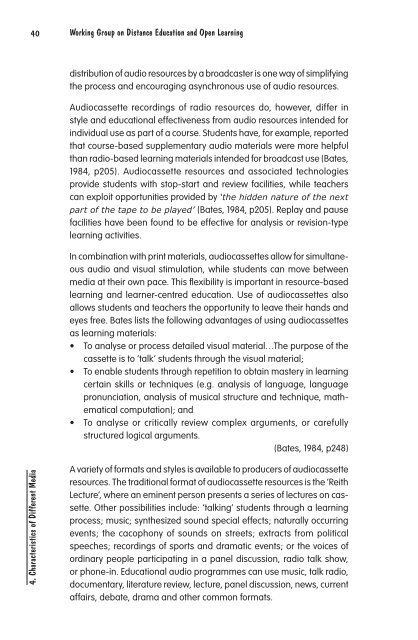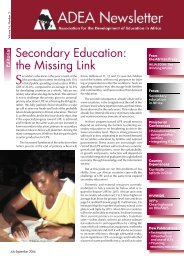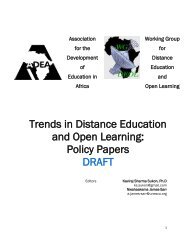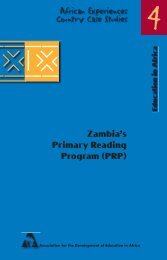Technological Infrastructure and Use of ICT in Education in ... - ADEA
Technological Infrastructure and Use of ICT in Education in ... - ADEA
Technological Infrastructure and Use of ICT in Education in ... - ADEA
You also want an ePaper? Increase the reach of your titles
YUMPU automatically turns print PDFs into web optimized ePapers that Google loves.
40 Work<strong>in</strong>g Group on Distance <strong>Education</strong> <strong>and</strong> Open Learn<strong>in</strong>g<br />
distribution <strong>of</strong> audio resources by a broadcaster is one way <strong>of</strong> simplify<strong>in</strong>g<br />
the process <strong>and</strong> encourag<strong>in</strong>g asynchronous use <strong>of</strong> audio resources.<br />
Audiocassette record<strong>in</strong>gs <strong>of</strong> radio resources do, however, differ <strong>in</strong><br />
style <strong>and</strong> educational effectiveness from audio resources <strong>in</strong>tended for<br />
<strong>in</strong>dividual use as part <strong>of</strong> a course. Students have, for example, reported<br />
that course-based supplementary audio materials were more helpful<br />
than radio-based learn<strong>in</strong>g materials <strong>in</strong>tended for broadcast use (Bates,<br />
1984, p205). Audiocassette resources <strong>and</strong> associated technologies<br />
provide students with stop-start <strong>and</strong> review facilities, while teachers<br />
can exploit opportunities provided by ‘the hidden nature <strong>of</strong> the next<br />
part <strong>of</strong> the tape to be played’ (Bates, 1984, p205). Replay <strong>and</strong> pause<br />
facilities have been found to be effective for analysis or revision-type<br />
learn<strong>in</strong>g activities.<br />
In comb<strong>in</strong>ation with pr<strong>in</strong>t materials, audiocassettes allow for simultaneous<br />
audio <strong>and</strong> visual stimulation, while students can move between<br />
media at their own pace. This flexibility is important <strong>in</strong> resource-based<br />
learn<strong>in</strong>g <strong>and</strong> learner-centred education. <strong>Use</strong> <strong>of</strong> audiocassettes also<br />
allows students <strong>and</strong> teachers the opportunity to leave their h<strong>and</strong>s <strong>and</strong><br />
eyes free. Bates lists the follow<strong>in</strong>g advantages <strong>of</strong> us<strong>in</strong>g audiocassettes<br />
as learn<strong>in</strong>g materials:<br />
• To analyse or process detailed visual material…The purpose <strong>of</strong> the<br />
cassette is to ‘talk’ students through the visual material;<br />
• To enable students through repetition to obta<strong>in</strong> mastery <strong>in</strong> learn<strong>in</strong>g<br />
certa<strong>in</strong> skills or techniques (e.g. analysis <strong>of</strong> language, language<br />
pronunciation, analysis <strong>of</strong> musical structure <strong>and</strong> technique, mathematical<br />
computation); <strong>and</strong><br />
• To analyse or critically review complex arguments, or carefully<br />
structured logical arguments.<br />
(Bates, 1984, p248)<br />
4. Characteristics <strong>of</strong> Different Media<br />
A variety <strong>of</strong> formats <strong>and</strong> styles is available to producers <strong>of</strong> audiocassette<br />
resources. The traditional format <strong>of</strong> audiocassette resources is the ‘Reith<br />
Lecture’, where an em<strong>in</strong>ent person presents a series <strong>of</strong> lectures on cassette.<br />
Other possibilities <strong>in</strong>clude: ‘talk<strong>in</strong>g’ students through a learn<strong>in</strong>g<br />
process; music; synthesized sound special effects; naturally occurr<strong>in</strong>g<br />
events; the cacophony <strong>of</strong> sounds on streets; extracts from political<br />
speeches; record<strong>in</strong>gs <strong>of</strong> sports <strong>and</strong> dramatic events; or the voices <strong>of</strong><br />
ord<strong>in</strong>ary people participat<strong>in</strong>g <strong>in</strong> a panel discussion, radio talk show,<br />
or phone-<strong>in</strong>. <strong>Education</strong>al audio programmes can use music, talk radio,<br />
documentary, literature review, lecture, panel discussion, news, current<br />
affairs, debate, drama <strong>and</strong> other common formats.

















